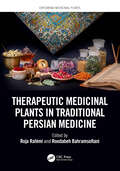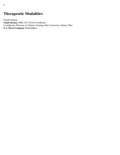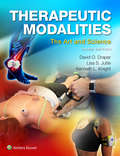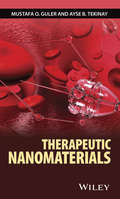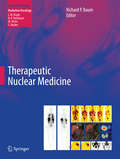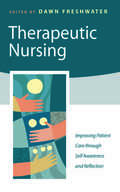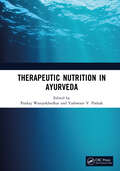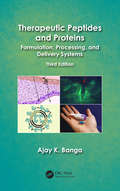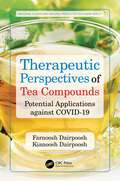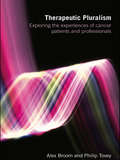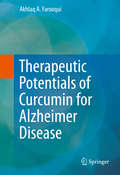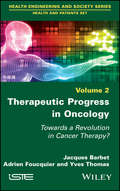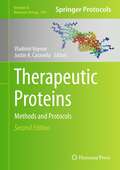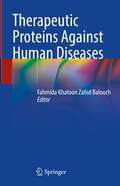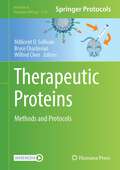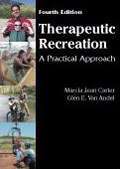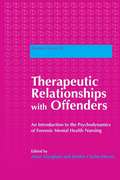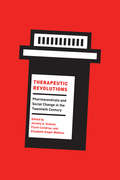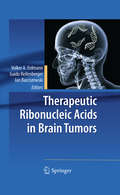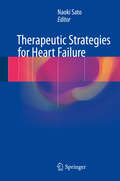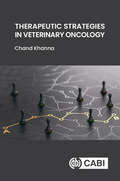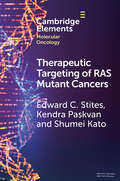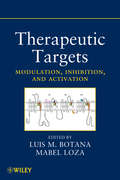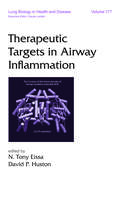- Table View
- List View
Therapeutic Lipidology (Contemporary Cardiology)
by Peter P. Toth Michael H. Davidson Kevin C. MakiThis book is an up-to-date and comprehensive reference on lipidology. It will serve as a stimulus to the reader to continue to learn about the ever changing and fascinating field of therapeutic lipidology. It will also empower readers to improve and extend the lives of the patients they so conscientiously serve.
Therapeutic Medicinal Plants in Traditional Persian Medicine (Exploring Medicinal Plants)
by Roja Rahimi Roodabeh BahramsoltaniTraditional Persian Medicine (TPM) is one of the oldest medical doctrines, globally known due to pioneering physicians and scientists. The greatest source of natural medicines in TPM originates from medicinal plants. Therapeutic Medicinal Plants in Traditional Persian Medicine provides a background on the history of TPM, as well as an introduction to 40 of the most popular medicinal plants used in TPM. It is a practical guide for readers interested in medicinal plants used in the prevention, management, and treatment of different diseases.Features: Includes both traditional therapeutic applications and modern evidence/ uses Makes a comparison between preclinical and clinical studies Provides information on major chemical constituents, therapeutic uses, adverse reactions, and safety for each plant species A volume in the “Exploring Medicinal Plants” series, this book is a valuable resource for researchers, students, academicians, and scientists dealing witth medicinal plants, as well as for those interested in the fields of pharmacognosy, naturopathy, phytotherapy, and traditional medicines.
Therapeutic Modalities
by Chad StarkeyThis book is an excellent resource for students or for experienced athletic trainers, physical therapists, or medical personnel. The numerous tables and illustrations and appendixes further enhance this friendlier edition. The 'at a glance' pages give the reader a quick overview of the text for each modality. Rather than using a cookbook method, the author encourages clinicians to use their own decision-making process to apply modalities appropriately, depending on the tissue depth and type, the injury, and the goal of therapy. An easy-to-follow reference as well as a suitable textbook for students.
Therapeutic Modalities: The Art and Science
by Dave Draper Lisa JutteIdeal for exercise science, athletic training, and physical therapy students, this updated edition of Knight and Draper’sTherapeutic Modalities: The Art and Science covers the knowledge and skills needed to select the best therapeutic modality for each client injury. This edition helps students hone their clinical decision-making skills by teaching both the how and the why of each therapeutic modality, offering the application that today’s student craves. Retaining the accessible student-friendly writing style and focus on kinesthetic learning that made the book so successful, the third edition is enhanced by new chapters, new photos, and significant updates throughout that reflect the latest research and advances in the field.
Therapeutic Nanomaterials
by Mustafa O. Guler Ayse B. TekinayAddressing a cutting-edge, multidisciplinary field, this book reviews nanomaterials and their biomedical applications. It covers regeneration, implants, adhesives, and biosensors and strategies for more efficient therapy, diagnosis, and drug delivery with the use of nanotechnology. - Addresses the increasing demand for nanomedicine in a cutting-edge, multidisciplinary field- Introduces concepts, strategies, and requirements of developing materials- Discusses hot topics in drug delivery, such as neural regeneration, cartilage regeneration, bone tissue regeneration, dental regeneration, biomedical imaging, tissue adhesives and biosensors- Includes a chapter about nanotoxicology to help readers further understand the biocompatability of nanomaterials
Therapeutic Nuclear Medicine
by Richard P. BaumThe recent revolution in molecular biology offers exciting new opportunities for targeted radionuclide therapy. This up-to-date, comprehensive book, written by world-renowned experts, discusses the basic principles of radionuclide therapy, explores in detail the available treatments, explains the regulatory requirements, and examines likely future developments. The full range of clinical applications is considered, including thyroid cancer, hematological malignancies, brain tumors, liver cancer, bone and joint disease, and neuroendocrine tumors. The combination of theoretical background and practical information will provide the reader with all the knowledge required to administer radionuclide therapy safely and effectively in the individual patient. Careful attention is also paid to the role of the therapeutic nuclear physician in coordinating a diverse multidisciplinary team, which is central to the safe provision of treatment.
Therapeutic Nursing: Improving Patient Care through Self-Awareness and Reflection
by Dawn Freshwater'I found the book to be fascinating and so thought provoking that it made me consider more carefully the text and prose to really understand what the author said. It is skilfully written, very readable and has implications for a wide range of people such as the undergraduate, practitioner, lecturer and researcher' - Accident and Emergency Nursing Gaining self-awareness is a vital aspect of professional development for all who work in the caring professions. In nursing especially, the ability to evaluate oneself affects all areas of practice, including direct patient care, working relationships with colleagues and maintaining one's own well-being in the often pressured environment of health care. This is an innovative text which explores the ways in which self-awareness can be used as a practical tool for continuing professional development and practice improvement. Divided into three parts, the book examines the role of the nurse as therapeutic practitioner, reflective learner and reflexive researcher. For all those wishing to develop their skills as autonomous, reflective, accountable practitioners, this book will be an inspiring read. It will be of immense use to those who teach and supervise nurses at all levels.
Therapeutic Nutrition in Ayurveda
by Yashwant V. Pathak Pankaj WanjarkhedkarNutrition remains the key to the successful treatment of diseases, in addition to the various evolved medical treatments across the world. The treatment outcome improves to a better extent with a degree of nourishment of the patients. Therapeutic Nutrition in Ayurveda (TNA) categorizes diseases system-wise and discusses nutrition with references from Ayurveda classics as well as publications from indexed journals in today’s world. This book emerges as a pilot project to discuss the clinical experiences directly and the concept of nutravigilance by experienced authors of respective specialties like hepatology, neurology, dermatology, ophthalmology, oncology, cardiology, gynecology, and so on. It broadly discusses diet and nutrition based on 12 different groups of diet in Ayurveda. Nutrition has been widely discussed for every disease dynamically in Ayurveda, with details of exclusion and inclusion of foods over a stipulated period or entire duration of treatment. Key Features: Presents system-wise and disease-wise therapeutic nutrition Includes clinical experience of physicians on therapeutic nutrition Contains interdisciplinary discussion on therapeutic nutrition with an integrated approach The integration of traditional and conventional health systems, along with the multidisciplinary approach, is the emerging trend for inclusive health care in the coming decades. This book serves as a handy guide for health care professionals across the continents, providing interdisciplinary correlations on nutrition.
Therapeutic Peptides and Proteins: Formulation, Processing, and Delivery Systems, Third Edition
by Ajay K. BangaThere are more than 500 biopharmaceuticals on the market, including more than 200 therapeutic proteins, making biologics the fastest growing sector in the biopharmaceutical market. These products include more than 40 monoclonal antibodies, for indications ranging from treatment or mitigation of various types of cancer to rheumatoid arthritis. The c
Therapeutic Perspectives of Tea Compounds: Potential Applications against COVID-19 (Medicinal Plants and Natural Products for Human Health)
by Farnoosh Dairpoosh Kianoosh DairpooshThis unique volume provides an insight into bioactive compounds of tea from studies of both chemical structures and pharmacological aspects. Examples of the beneficial health effects of tea compounds in managing health problems and diseases are presented, with an emphasis on viral diseases such as COVID-19. Vaccines are not always available in many countries, thus simple and inexpensive measures which are easily available to help mitigate for example, the COVID-19 pandemic, are urgently needed. Dietary bioactive compounds could be alternative nutritional approaches in combating infection in addition to existing therapies and also upcoming vaccines and drugs, by enhancing their efficacy. Features : Emphasizes the antiviral activity of the tea compounds and the latest findings against Coronavirus and SARS-Cov-2. Provides a general overview of tea constituents, chemical structures of these compounds and their potential health benefits. Tea is one of the most commonly used beverages around the world and people with different backgrounds will be interested in reading about its health benefits. Correlating the therapeutic effect of tea components with COVID-19 is extremely beneficial for health care team members and general population. Assists the reader in understanding the therapeutic value of using tea to tackle COVID-19 symptoms, offering simple, inexpensive tips to help mitigate the virus.
Therapeutic Pluralism: Exploring the Experiences of Cancer Patients and Professionals
by Alex Broom Philip ToveyThe profile of complementary and alternative medicine (CAM) has risen dramatically over the last decade and cancer patients represent its most prolific users. As a result, the NHS and UK cancer services are attempting to develop a wider range of therapeutic options for patients. Despite such developments, little is known about why cancer patients use CAM, its perceived benefits and the perspectives of the doctors and nurses involved. Drawing on extensive fieldwork in the UK, Therapeutic Pluralism includes over 120 interviews with cancer patients and professionals, plus innovative ‘diary’ data which, for the first time, detail the experiences of CAM users. It gives a systematic analysis of issues such as: The development of patient preferences and influences on decision making Expectations of CAM and interpretations of ‘success’ in cancer treatment The nature and importance of ‘evidence’ and ‘effectiveness’ for patients The organisational dynamics involved in integrating CAM into the NHS Pathways to CAM and the role of the Internet The role of oncology clinicians in patients’ experiences of cancer and their use of CAMs Therapeutic Pluralism is essential reading for students and researchers of medical sociology, complementary and alternative medicine and cancer. It will also be useful to medical and health professionals, and policy-makers with an interest in complementary and alternative medicine.
Therapeutic Potentials of Curcumin for Alzheimer Disease
by Akhlaq A. FarooquiThis is the first book on the market that explores the importance of curcumin for the treatment of neurological disorders. It has been estimated that 35. 6 million people globally had dementia in 2010 and the prevalence of dementia has been predicted to double every 20 years. Thus, 115. 4 million people may be living with dementia in 2050. Alzheimer's disease (AD) is the leading cause of dementia and is present in 60%-70% of people with dementia. Unless new discoveries are made in the prevention or treatment of AD, the number of cases in the US alone is estimated to increase threefold, to 13. 2 million by the year 2050. Thus, it is important to focus on delaying and treating the onset of AD by curcumin may be an important step for controlling AD. Regular consumption of healthy diet containing curcumin enriched foods, moderate exercise, and regular sleep may produce beneficial effects not only on motor and cognitive functions, but also on memory deficits that occur to some extent during normal aging and to a large extent in AD. Delaying the onset and progression of AD and improving its symptoms by few years with regular consumption of curcumin may relieve some of the burden on health care systems. In service of this goal, this volume gives readers a comprehensive and cutting edge description of the importance of curcumin for the treatment of AD in cell culture and animal models in a manner that is useful not only to students and teachers but also to researchers, dietitians, nutritionists and physicians. It can be used as supplement text for a range of neuroscience and nutrition courses. Clinicians, neuroscientists, neurologists and pharmacologists will find this book useful for understanding molecular aspects of AD treatment by curcumin.
Therapeutic Progress in Oncology: Towards a Revolution in Cancer Therapy?
by Jacques Barbet Adrien Foucquier Yves ThomasThe combined effects of population growth and aging have led to an increase in the number of cancers. Preventing, diagnosing, treating and curing cancer are therefore, more than ever, imperatives facing medicine – especially to continue the decrease in cancers' mortality rates and to improve the quality of survival. Over time, the "classic" modes of treatment (surgery, external beam radiotherapy, chemotherapy) have become more refined and efficient. From the beginning of this century, new therapeutic options have been developed: targeted cancer therapy, targeted radionuclide therapy and immunologic therapies based on monoclonal antibodies, cellular therapy and vaccinations. Artificial intelligence and machine learning are also being introduced to the field of oncology. Starting with the basic scientific principles relevant to oncology, this book explains and makes these concepts and innovations accessible to a wide audience – especially in the interest of patients. It also contributes to the oncological field of 4P medicine – with 4P standing for predictive, preventive, personalized and participative.
Therapeutic Proteins
by Vladimir Voynov Justin A. CaravellaAfter the identification of a potential protein drug, the next critical step is the production of sufficient authentic material for testing, characterization, and clinical trials, which, when successful, leads to the need for robust methodologies for large-scale production, purification, characterization, viral inactivation, and continued testing of the final protein product. Building on the valuable first edition, Therapeutic Proteins: Methods and Protocols, Second Edition aims to cover each of these key aspects of protein drug production through the contributions of authors from highly esteemed industrial and academic institutions around the world. Emphasizing the newest developments in the field, this second edition also includes additional emphasis on discovery, including new display and screening methods as well as the design and engineering of new types of therapeutic proteins. There is also discussion of computational and bioinformatics methods, and chapters on safety aspects of therapeutic protein development. Written in the highly successful Methods in Molecular BiologyTM format, protocol chapters include introductions to their respective topics, lists of the necessary materials and reagents, step-by-step, readily reproducible laboratory protocols, and tips on troubleshooting and avoiding known pitfalls. Fully updated and practical, Therapeutic Proteins: Methods and Protocols, Second Edition provides an essential resource to all scientists working in the field of therapeutic proteins.
Therapeutic Proteins Against Human Diseases
by Fahmida Khatoon Zahid BalouchThis book compiles updated research about the implications of therapeutic proteins in various human diseases. The initial chapters of the book provide basic information on the therapeutic proteins and discuss techniques for their formulation, production, and analytic approaches for their characterization. The subsequent chapters shed light on therapies based on therapeutic proteins against metabolic disorders, neurological disorders, cancer, autoimmune disorders, and infectious diseases. Importantly, it presents the factors influencing the immunogenicity of therapeutic proteins, including, genetic factors, disease type, and origin of therapeutic protein, dose frequency, administration route, and treatment duration. The book also reviews the strategies for reducing immunogenicity associated with therapeutic proteins, including PEGylation, site specific mutagenesis, exon shuffling, and humanizing of monoclonal antibodies. Further, it presents strategies for improving the typical drawback associated with protein therapeutics including instability and limited penetration through biological barriers. This book covers various computational methods that are commonly used for designing therapeutic proteins and in silico method for predicting and improving in vivo efficacy of the therapeutic molecules. Lastly, the book highlights the recent advances in developing nanosized delivery systems to improve safety and efficacy of protein therapeutics.This book caters to students and researchers of medicinal chemistry, pharmaceutical sciences and therapeutics. It is also useful to clinicians working with therapeutic proteins.
Therapeutic Proteins: Methods and Protocols (Methods in Molecular Biology #2720)
by Millicent O. Sullivan Bryce Chackerian Wilfred ChenThis volume covers the latest key aspects of therapeutic protein applications. Chapters in this book cover topics such as the discovery, production, and conjugation of protein-proteins with discussions on the direction of future development and advancements; ways to use these engineering proteins for therapeutic and vaccine applications; and the use of modified protein nanocarriers. Written in the highly successful Methods in Molecular Biology series format, chapters include introductions to their respective topics, lists of the necessary materials and reagents, step-by-step, readily reproducible laboratory protocols, and tips on troubleshooting and avoiding known pitfalls.Cutting-edge and practical, Therapeutic Proteins: Methods and Protocols is a valuable resource for any researcher who are interested in learning more about the field of therapeutic proteins.
Therapeutic Recreation: A Practical Approach (Fourth Edition)
by Marcia Jean Carter Glen E. Van AndelThe fourth edition of Therapeutic Recreation: A Practical Approach reflects the still-evolving nature of this health-care profession and practice in a diverse global world. Social, cultural, demographic, and economic shifts, as well as technological advancements, have created demand for fiscal accountability by informed consumers/clients who expect safe, quality health and human services that are reliable, responsive to their needs, and have proven benefits. Thus our intention is to provide, in a practical, student-oriented fashion, a comprehensive overview of the fundamentals of therapeutic recreation as a health and human service profession and as a career choice. This revised edition is primarily designed for an introductory course in therapeutic recreation at the undergraduate level. Students majoring in health and human service programs or recreation may also find the text useful, particularly if they anticipate careers in health-care settings and agencies that offer inclusionary programs.
Therapeutic Relationships with Offenders: An Introduction to the Psychodynamics of Forensic Mental Health Nursing
by Gwen Adshead Tom Clarke Anne Aiyegbusi Valerie Anne Brown Jenifer Clarke-MooreWorking in any area of mental health nursing presents complex issues regarding the nurse-patient relationship. For those working in prolonged clinical contact with offenders, relationships with patients and colleagues can be particularly emotionally intense and sometimes difficult to express. This book attempts to understand and articulate the emotional labour of forensic nursing and explores the challenge of establishing and maintaining therapeutic relationships with offenders. The first book to consider the emotional and relational component of forensic mental health nursing, the chapters cover a number of specialist forensic areas from this psychodynamic perspective, such as women's services, services for people with personality disorders, intensive care, high security psychiatric hospitals, medium secure units and services for adolescent offenders. A chapter on therapeutic communities is also included, along with chapters on challenging relational phenomena such as working with hate and the difficulties of managing difference when working in environments that produce high levels of anxiety. Therapeutic Relationships with Offenders provides essential information for mental health nurses working in the forensic field and will be of interest to any professionals working with challenging populations and people with personality disorders.
Therapeutic Revolutions: Pharmaceuticals and Social Change in the Twentieth Century
by Elizabeth Siegel Watkins Flurin Condrau Jeremy A. GreeneWhen asked to compare the practice of medicine today to that of a hundred years ago, most people will respond with a story of therapeutic revolution: Back then we had few effective remedies, but now we have more (and more powerful) tools to fight disease, from antibiotics to psychotropics to steroids to anticancer agents. This collection challenges the historical accuracy of this revolutionary narrative and offers instead a more nuanced account of the process of therapeutic innovation and the relationships between the development of medicines and social change. These assembled histories and ethnographies span three continents and use the lived experiences of physicians and patients, consumers and providers, and marketers and regulators to reveal the tensions between universal claims of therapeutic knowledge and the actual ways these claims have been used and understood in specific sites, from postwar West Germany pharmacies to twenty-first century Nigerian street markets. By asking us to rethink a story we thought we knew, Therapeutic Revolutions offers invaluable insights to historians, anthropologists, and social scientists of medicine.
Therapeutic Ribonucleic Acids in Brain Tumors
by Jan Barciszewski Volker A. Erdmann Guido ReifenbergerIn the past few years nucleic acids technologies have grown into a powerful analytical and also increasingly therapeutic tool. It has been applied not only to the uncovering of gene functions in many organisms, but also to pathogenetic analysis and recently also for the treatment of human diseases. The book discusses in depth the potential of these innovative methods in the broad field of central nervous system and brain tumours particularly. Whereas there is currently no comprehensive overview on potential and challenges of nucleic acids technologies for basic brain tumours and for the clinical management of patients with brain tumours, this book does explicitly cover the many other aspects of the "RNA World" (pathogenic and therapeutic potential of microRNAs, aptamer technology, etc.), too. With this significantly broadened scope as compared to currently existing books it appears to be an urgently needed new publication.
Therapeutic Strategies for Heart Failure
by Naoki SatoThis book introduces practical heart failure (HF) managements at the acute, in-hospital stages during hospitalization and also in the end-stages of HF, including the difference compared to the rest of the world. Given its increasing incidence and prevalence, we live in a world facing an HF pandemic. As one of the countries with outstanding longevity, Japan has unique characteristics concerning the selection of medical treatment, diagnostic techniques, team managing and other treatments. This book sheds light on the clinical challenges involved in reducing re-hospitalization and improving the prognosis and the ADL/QOL of the patients, and reports on the status quo in Japan, comparing to the rest of the world. Sharing these challenges and methods used to address them should encourage the world's experts to intensively discuss and accelerate research on the clinic in this field. The editors and authors have taken on central roles in managing HF in Japan. It will be indispensable not only for clinicians, technicians and nurses in this field, but also for general physicians, emergency physicians and others who are involved in intensive care.
Therapeutic Strategies in Veterinary Oncology
by Nicole Amato Jacob Cawley Steven Dow Joelle Fenger Andi Flory Ira Gordon Kayla Harding Kelvin Kow Cheryl London Nicola Mason Arata Matsuyama Jonathan Mochel Anthony Mutsaers Henrik Rönnberg Wesley WiersonThis book is a comprehensive resource for veterinary oncologists and trainees, covering therapeutic strategies used in the treatment of veterinary patients. In the setting of a rapidly changing field like oncology, this timely text focuses on mechanisms of action and biological rationale rather than current specific clinical recommendations, allowing current and future clinicians to adapt treatment approaches as our understanding of the biology of cancer evolves. With each chapter written by experts in their field, this book provides informative figures that convey this biological understanding and rationale of therapy. It starts from the mechanisms of treatment as we currently understand them, covering radiation therapy, chemotherapy, immunotherapy, targeted therapy, and many more. Dispensing vital, detailed and practical information about the different therapeutic strategies available, this book is a vital resource for practicing veterinarians, while also providing students of veterinary oncology with a better understanding of the key differences between different treatment strategies.
Therapeutic Targeting of RAS Mutant Cancers (Elements in Molecular Oncology)
by Edward C. Stites Kendra Paskvan Shumei KatoThe KRAS oncogene is believed to be the most common single nucleotide variant oncogene in human cancer. Historically, efforts to target KRAS and the other RAS GTPases have struggled. More recently, efforts have focused on identifying and exploiting features unique to specific oncogenic mutations. This has led to the first FDA approval for a RAS targeted therapy. This new agent is a covalent inhibitor that reacts with the cysteine residue created by a codon 12 glycine to cysteine (G12C) mutation within KRAS. Mutant-specific strategies may also exist for other KRAS single nucleotide variants, and recent studies provide examples and mechanisms.
Therapeutic Targets
by Mabel Loza Luis M. BotanaThe Latest Applications For Cellmechanism Research in Drug DiscoveryDesigned to connect research on cell mechanisms with the drug discovery process, Therapeutic Targets: Modulation, Inhibition, and Activation introduces readers to a range of new concepts and novel approaches to drug screening and therapeutic drug targeting to help inform future avenues of drug research. Highly topical, this accessible edited volume features chapters contributed by respected experts from around the globe.The book helps postgraduate students and professional scientists working in academia and industry understand the molecular mechanisms of pharmacology, current pharmacological knowledge, and future perspectives in drug discovery, focusing on important biochemical protein targets and drug targeting strategies for specific diseases. Examining the pharmacology of therapeutically undefined targets and their potential applications, it includes chapters on traditional therapeutic targets, including enzymes (phosphodiesterases and proteases), ion channels, and G protein-coupled receptors, as well as more recently identified avenues of exploration, such as lipids, nuclear receptors, gene promoters, and more.Since different diseases require different targeting techniques, the book also includes dedicated chapters on strategies for investigating Alzheimer's, diabetes, pain, and inflammation treatments. Concluding with a cross-sectional look at new approaches in drug screening, Therapeutic Targets is an invaluable resource for understanding where the next generation of drugs are likely to emerge.
Therapeutic Targets in Airway Inflammation (Lung Biology in Health and Disease)
by N. Tony Eissa David P. HustonThis reference examines the cellular, molecular, and genetic mechanisms involved in airway inflammation, as well as the pathophysiology, epidemiology, and aetiology of asthma. It explores strategies to prevent cellular injury and oxidative tissue damage, inhibit key inflammatory pathways and identify disease-specific targets to reduce the induction

